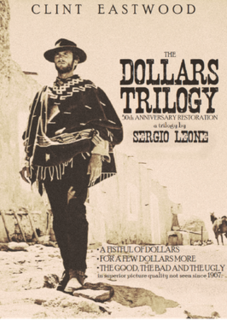
The Good, the Bad and the Ugly is a 1966 Italian epic spaghetti Western film directed by Sergio Leone and starring Clint Eastwood as "the Good", Lee Van Cleef as "the Bad", and Eli Wallach as "the Ugly". Its screenplay was written by Age & Scarpelli, Luciano Vincenzoni, and Leone, based on a story by Vincenzoni and Leone. Director of photography Tonino Delli Colli was responsible for the film's sweeping widescreen cinematography, and Ennio Morricone composed the film's score, including its main theme. It is an Italian-led production with co-producers in Spain, West Germany, and the United States. Most of the filming took place in Spain.

A tuco-tuco is a neotropical rodent in the family Ctenomyidae. Tuco-tucos belong to the only living genus of the family Ctenomyidae, Ctenomys, but they include approximately 60 different species. The common name, "tuco-tuco" comes from the "tuc-tuc" sound they make while they dig their burrows.

Dollars Trilogy, also known as the Man with No Name Trilogy or the Blood Money Trilogy, is an Italian film series consisting of three Spaghetti Western films directed by Sergio Leone. The films are titled A Fistful of Dollars (1964), For a Few Dollars More (1965) and The Good, the Bad and the Ugly (1966). Their English versions were distributed by United Artists, while the Italian ones were distributed by Unidis and PEA.

Haig's tuco-tuco, known regionally as the Patagonian tuco-tuco, is a South American hystricognath rodent. Like other tuco-tucos it is subterranean and thus not often observed, although the "tuc-tuc" call of the males can be heard near burrow sites, especially in early morning. Like most species in the genus Ctenomys, C. haigi are solitary, with one adult per burrow.

The Brazilian tuco-tuco is a tuco-tuco species from South America. It is found mainly in the state of Minas Gerais in southeastern Brazil, though Charles Darwin mentions it during his trip through present-day Uruguay.

The tiny tuco-tuco is a tuco-tuco species from South America. It is found in Brazil.
Natterer's tuco-tuco is a tuco-tuco species from South America. It is found in Bolivia and Brazil. It is sometimes considered to be conspecific with, or a subspecies of, the Bolivian tuco-tuco, Ctenomys boliviensis,

The collared tuco-tuco is a tuco-tuco species from South America. It is found in southern Brazil, Uruguay and northern Argentina where it lives underground in a burrow it digs in savannah habitats. It is a relatively common species and the IUCN has assessed its conservation status as being of "least concern".

Raymond Cruz is an American actor, best known for his starring role as Detective Julio Sanchez in the series The Closer and its spinoff Major Crimes, as well as his recurring role as the drug lord Tuco Salamanca in the crime drama Breaking Bad and its spin-off Better Call Saul.
The southern tuco-tuco is a species of rodent in the family Ctenomyidae. It is endemic to Argentina.
The Maule tuco-tuco is a species of rodent in the family Ctenomyidae. It is found in Argentina and Chile where it occupies several different types of habitats. It is a common species and the IUCN has assessed its conservation status as being of "least concern". The common and scientific names refer to a river and region in Chile within its range.
The highland tuco-tuco is a species of rodent in the family Ctenomyidae. It is found in high grassland in Argentina, Bolivia, Chile, and Peru where it lives in burrows.
The social tuco-tuco is a species of rodent in the family Ctenomyidae. It is endemic to Argentina. Its natural habitat is subtropical or tropical dry lowland grassland.

The Talas tuco-tuco is a species of tuco-tuco endemic to eastern Argentina.
The robust tuco-tuco is a species of rodent in the family Ctenomyidae. It is a burrowing rodent and is endemic to the Tucumán Province of Argentina.

"Crazy Handful of Nothin'" is the sixth episode of the first season of the American television drama series Breaking Bad. Written by George Mastras and directed by Bronwen Hughes, it aired on AMC in the United States and Canada on March 2, 2008. The episode introduces Tuco Salamanca and No Doze, played by Raymond Cruz and Cesar Garcia respectively.
The Puntilla tuco-tuco is a species of rodent in the family Ctenomyidae. It is endemic to central Argentina. The common name of the species comes from the municipality of La Puntilla at the type locality. It was first described by the British zoologist Oldfield Thomas in 1920 after being collected by Emilio Budin, an Argentine specimen collector who worked with Oldfield Thomas.

"Seven Thirty-Seven" is the second season premiere episode of the American television drama series Breaking Bad. It was written by J. Roberts and directed by series star Bryan Cranston.

"Grilled" is the second episode of the second season of the American television drama series Breaking Bad. It was written by George Mastras and directed by Charles Haid.
This page is based on this
Wikipedia article Text is available under the
CC BY-SA 4.0 license; additional terms may apply.
Images, videos and audio are available under their respective licenses.










